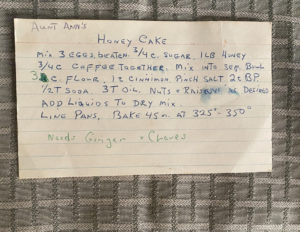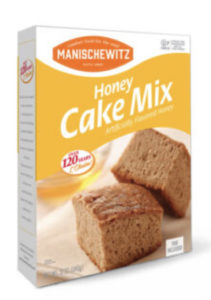We are reposting this honey cake article from 2020, lest these recipes sink out of sight in the list of blog posts, and our holiday baking suffers. But first, an article on the history of honey cake from Janet Stein-Larson of the kitchen Committee.
The Kitchen Corner: Honey Cake
And to get you in the mood for the High Holy Days and in honor of the returning of the honey cakes for this erev Rosh Hashanah celebration; here is the reprint of the Shofar Article done for Sept/Oct 2020 to help inspire those volunteers who wish to bake honey cake for the upcoming erev Rosh Hashanah Oneg.
Ahh, Honey Cake.. Rosh Hashanah is coming soon; and you are probably thinking of apples, honey, round sweet Challah, and Honey Cake. Honey Cake is one of the ways we wish for a sweet New Year. How many of you enjoyed champagne, apples, honey, and home baked Honey Cakes after Congregation Beth Ami’s erev Rosh Hoshanah services.
It didn’t start that way. A long time ago, back in ancient history in the ancient Near East sweet honey ‘cakes’ were made of mashed legumes and honey. In Egypt, light cakes were made from a yeast dough and honey. Romans baked barley loaves with honey, raisins, pine nuts, and pomegranates With Arabic trading, proto-honey cakes were spread to Spain and Sicily and worked up the Italian coast. Italian Jews migrated north in Europe and by the early 11th century dense cakes of honey and breadcrumbs were being baked by Jewish bakers in central and western Europe.
By the 1300s in Germany, these cakes with honey were popular with Jewish and non-Jewish bakers. Lebkuchen (gingerbread) and Lekach (honey cake) evolved, and so did other forms of ‘honey cake’.
As a treat for the first day of learning young yeshiva students were rewarded with honey to represent the sweetness of the words of Torah. The celebration continued afterwords with Honey Cake, apples, and hard boiled eggs. By the time the dish traveled to Eastern Europe, Honey Cakes were traditionally used by the Jewish population for special occasions and holidays alike.
What do you think when you think of Honey Cake? Do you think of a dense, brown, sweet and heavy cake tasting of cloves? You are not alone. However, this ‘dense cake with honey’ was an answer to no refrigeration. The honey sweetened and prevented bacterial growth. In fact, the cake actually got better as it aged because the honey would attract moisture as it sat in your cupboard. The ways to make it were as varied as the spices you use for it. Various recipes included tea, coffee, apple sauce, orange juice, and/or a shot of booze with oil to lighten the batter. Spices, raisons, nuts and/or zest all added to the flavor.
Even though by the 1700s, cakes were evolving away from the Honey Cake, to this day it still is a traditional comfort food to enjoy, especially around the holidays. One of the enjoyments of this time of year is the comparison of old family Honey Cake recipes, and perhaps the goal of improving the old standby Honey Cake recipe to meet our current tastes. You can check the Kitchen Committee blogs on our web site for their recipe collection: https://bethamisr.org/2022/08/honey-cake-stories-and-recipes/
Shanah tovah u’metukah.
—Janet Stein-Larson,
The best Honey Cake in my parent’s family was from my father’s side of the family; his Aunt Ann’s Honey cake. Below is the recipe from my mother’s recipe file. Of course, if you look carefully, you’ll see her comments for improving it to her taste. Caution: if you choose to follow it; it took Jeffrey 3 times to try and get the flavor and texture correct. We have the notes..
On my mother’s side of the family we don’t have any family recipes of Honey Cake. The reason is simple, they didn’t enjoy baking as much as dad’s side. My recipe for Honey Cake ended up being an potschked version of…
using coffee and applesauces to replace some of the liquids… No booze, no orange juice, simple….
~janet Stein-Larson
Nana’s Honey Cake
Servings: 12 Preparation Time: 2 hours
Pre-heat oven to 300
-
6 eggs
-
1 1/2 cups sugar
-
1 1/2 cups honey
-
1 1/3 cups oil
-
1 1/4 cups hot water mixed with 6 teaspoons instant coffee (try my tea)
-
2 teaspoons baking powder
-
1 teaspoon baking soda
-
3 1/2 cups flour
-
1/2 teaspoon allspice
-
2 teaspoons ginger
-
2 teaspoons cinnamon
-
3/4 teaspoon cloves
-
1/2 teaspoon nutmeg
-
1/2 cup whiskey or Korbel Brandy
Beat eggs and sugar. Add all liquids and mix. Then add dry ingredients. Line 2 8×8 pans with wax paper or parchment and spray with cookong oil. Bake at 300 for approximately 1 hour, until an inserted knife comes out clean. You can also pour the batter in 1 9×13 pan.
Note: reader suggests bake time more like 1 ½ hours.
9-11-2019 8×8 pans baked in 1 hour but gave extra 10 min and are OK.
Recipe 2
Ingredients
- 1 cup (113g) sliced almonds
- 1 1/4 cups (142g) King Arthur Whole Wheat Flour, white or traditional
- 3/4 cup (99g) King Arthur Unbleached All-Purpose Flour
- 1/2 teaspoon baking soda
- 1/2 teaspoon salt
- 3/4 cup (170g) unsalted butter, at room temperature, at least 65°F
- 1 cup (340g) honey
- 4 large eggs, at room temperature
- 1/4 cup (57g) sour cream or yogurt, at room temperature
Instructions
- Preheat the oven to 325°F. Lightly grease a 9-inch round cake pan. Sprinkle 3/4 cup of the sliced almonds in the bottom of the pan, reserving 1/4 cup for the batter.
- In a medium bowl, whisk together the flours, baking soda, and salt; set aside. In a large mixing bowl, mix together the butter, honey, and eggs. Stir in the reserved flour mixture, then the sour cream or yogurt and reserved almonds.
- Scrape the sides and bottom of the bowl to be sure everything is evenly moistened, then mix for one minute more.
- Gently pour the batter over the almonds in the prepared pan.
- Bake for 50 to 55 minutes, until the edge of the cake pulls back from the edge of the pan. Remove from the oven and place on a rack to cool for 15 minutes. After 15 minutes, invert the cake onto a serving plate and allow it to cool before serving.
- Decorate the top with powdered sugar if desired.






